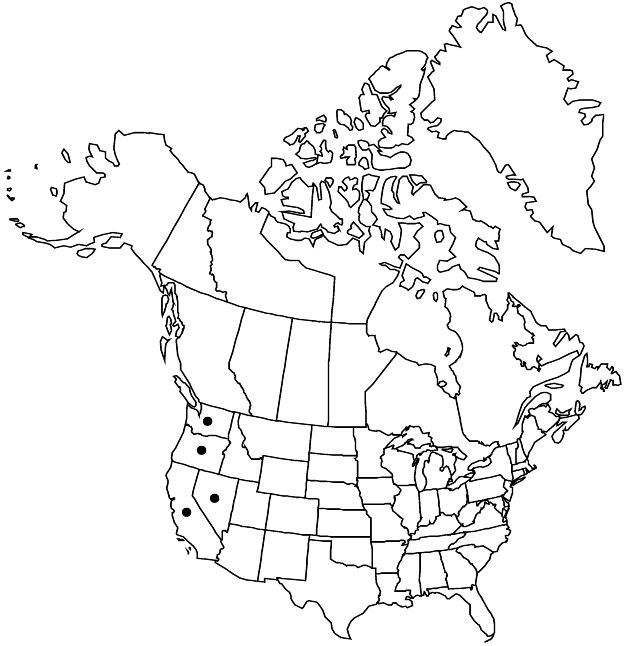Potentilla breweri
Proc. Amer. Acad. Arts 8: 555. 1873.
Plants rosetted to ± matted; taproots not fleshy-thickened. Stems prostrate to ascending, (0.5–) 1–3 (–4.5) dm, lengths 2–4 (–5) times basal leaves. Basal leaves pinnate with distal leaflets ± confluent, (2–) 4–12 (–17) × 1–2.5 (–5) cm; petiole 1–3 (–7) cm, straight hairs mostly absent, cottony hairs sparse to dense, glands absent or obscured to common; primary lateral leaflets 3–6 per side, on distal 1/2–2/3 (–3/4) of leaf axis, ± overlapping, largest ones cuneate-flabellate, 0.5–1.5 (–2.5) × 0.4–2 (–3) cm, distal 1/2 to whole margin unevenly incised 1/2 to completely to midvein (blade often medially split as well), ultimate teeth or segments 3–10, narrowly elliptic, 2–10 (–15) × 1–3 (–5) mm, apical tufts less than 1 mm, surfaces grayish green to white, not glaucous, straight hairs sparse to common (sparser adaxially), loosely appressed to ascending, 1–1.5 mm, soft, cottony hairs sparse to dense, glands sparse or obscured to common. Cauline leaves 1–3. Inflorescences 2–15 (–25) -flowered, openly cymose. Pedicels (1–) 1.5–2.5 (–4) cm, straight in fruit. Flowers: epicalyx bractlets lanceolate to ovate, 2–5 × 1–1.5 mm; hypanthium (3–) 4–5 mm diam.; sepals (3–) 4–7 mm, apex acute; petals 5–9 (–10) × 4–8 (–10) mm; filaments (1–) 2–4 mm, anthers (0.5–) 1 mm; carpels 15–25, styles 2–3 mm. Achenes 1.8 mm, smooth, not carunculate. 2n = 72–73, 99, 100, 102.
Phenology: Flowering summer.
Habitat: Rocky meadows, seasonally moist flats, rock crevices, often near streams and lakes
Elevation: 1500–3600 m
Distribution

Calif., Nev., Oreg., Wash.
Discussion
Of conservation concern.
Potentilla breweri differs from other members of sect. Multijugae in its often dense, cottony vestiture. Density of cottony hairs and leaflet dissection can differ significantly between first-formed and mid- to late-season leaves of P. breweri; in the description above, leaves are those predominant at anthesis.
Potentilla breweri is most common in the Sierra Nevada of California, with sporadic occurrences to the Cascade Range in southern Washington. Disjunct populations occur in the Ruby and Snake ranges in Nevada and on Steens Mountain in Oregon, where often introgressed with P. versicolor. Reports from Utah are based on collections of P. concinna var. proxima or possible hybrids between P. concinna var. proxima and P. ovina var. decurrens.
J. Clausen et al. (1940) concluded that Potentilla breweri (with P. versicolor as synonym) belonged with P. bruceae and P. drummondii as members of a cenospecies that probably also included unnamed species (possibly P. ovina var. decurrens) from the mountains of Colorado, Utah, and Wyoming. Chromosome number varied within populations, and high numbers of univalents were present.
Recognition of Potentilla breweri as a distinct species differs from recent treatments in which it was considered to be a variety or subspecies of P. drummondii, parallel to the treatment of P. bruceae. The present continental perspective of the genus, as well as additional fieldwork, has resulted in the return of all three to species rank (B. Ertter and D. Mansfield 2007). Placement of P. breweri in sect. Multijugae, separate from P. bruceae and P. drummondii in sect. Graciles, is based on the commonly prostrate habit, fully pinnate leaves, and deeply divided overlapping leaflets.
Although B. C. Johnston (1980) used Potentilla breweri var. viridis Jepson to accommodate greener-than-average sparsely cottony plants, including populations treated here as P. versicolor, the type is probably a sterile hybrid with P. wheeleri as one parent (B. Ertter 1992). The type of P. millefolia var. algida Jepson (included by Johnston in the synonymy of var. viridis) and comparable plants from north-central California combine features of P. breweri and P. versicolor but are more glandular than either. This variant, as well as exceptionally small plants from the Warner Mountains of California, may prove distinct.
Selected References
None.
Lower Taxa
"thin" is not a number."dm" is not declared as a valid unit of measurement for this property."-4(-5)timesbasalleaves" is not declared as a valid unit of measurement for this property."dm" is not declared as a valid unit of measurement for this property."dm" is not declared as a valid unit of measurement for this property.